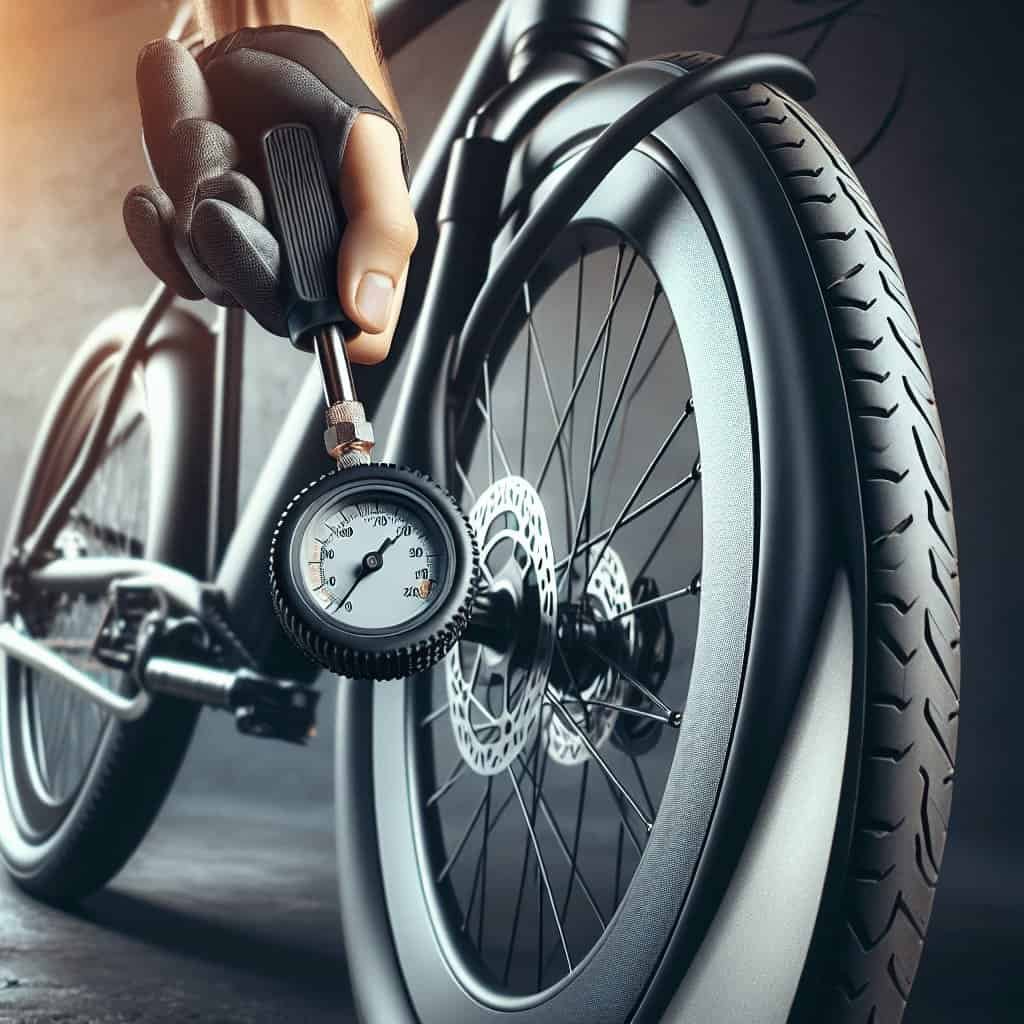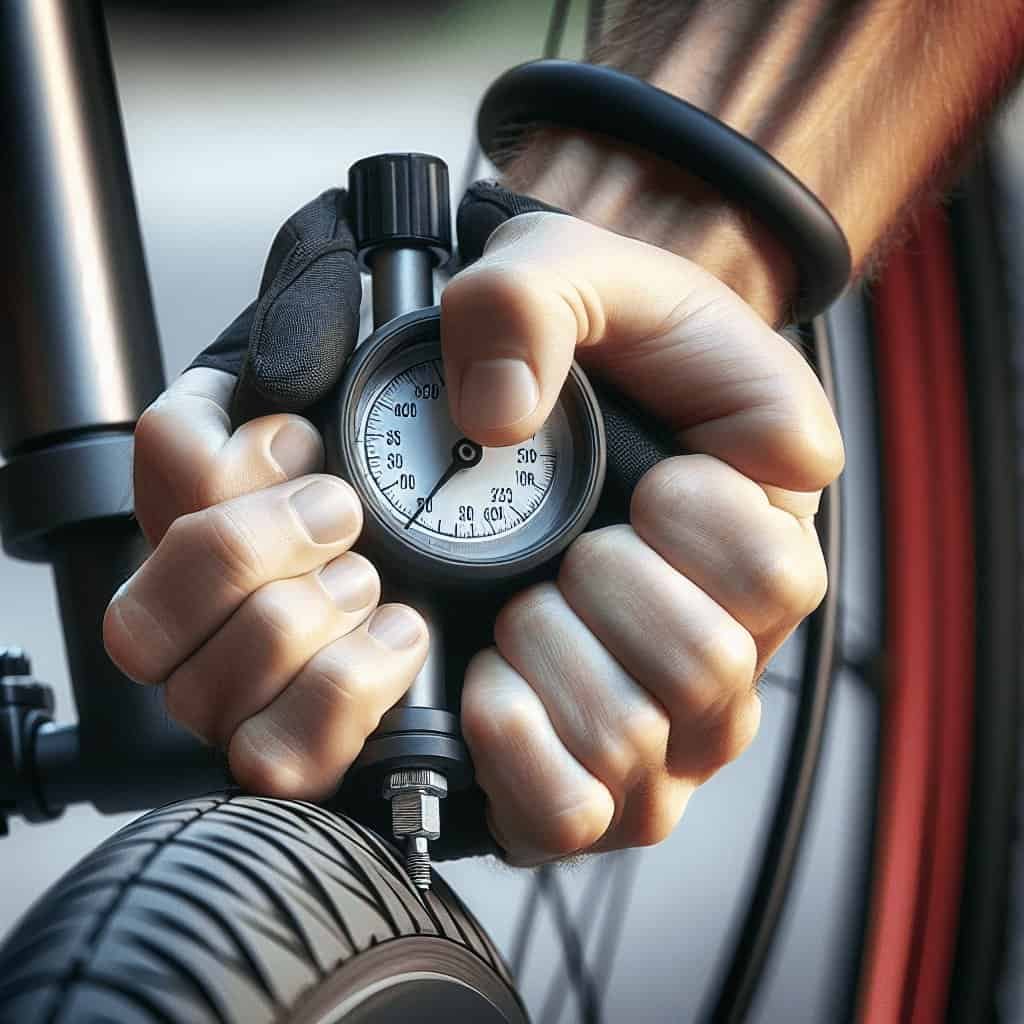Have you ever wondered how to properly check and inflate the tires on your electric bike? Keeping your tires properly inflated is essential for a smooth and safe ride. In this article, we will explore the simple steps you can take to ensure your electric bike’s tires are in top condition. From checking the pressure to using the right tools, we’ve got you covered. So, let’s dive in and learn how to keep your electric bike rolling smoothly!

Checking Tire Pressure
Why is it important to check tire pressure?
Checking tire pressure is important for several reasons. Firstly, proper tire pressure ensures optimal performance and safety while riding your electric bike. When the tires are inflated to the recommended pressure, it allows for better traction, handling, and control on the road. Additionally, proper tire pressure helps to prevent flats and excessive wear, extending the lifespan of your tires.
What is the recommended tire pressure for electric bikes?
The recommended tire pressure for electric bikes can vary depending on the specific model and tire size. It is essential to refer to the manufacturer’s guidelines for the recommended tire pressure. Generally, electric bikes have higher recommended tire pressure compared to regular bikes. This is because electric bikes are heavier and require more air pressure to support the additional weight.
How often should you check tire pressure?
You should check your electric bike tire pressure regularly, ideally at least once a week. This frequent check is necessary because tires lose air over time, and improper tire pressure can affect the performance and safety of your electric bike. Additionally, external factors such as temperature changes and riding conditions can also impact tire pressure. Therefore, it is crucial to maintain a routine of checking tire pressure to ensure optimal performance and safety.
What tools do you need to check tire pressure?
Checking tire pressure on an electric bike requires a few essential tools. Firstly, you will need a tire pressure gauge to accurately measure the air pressure in your tires. There are various types of gauges available, including digital and analog options. Choose one that is easy to use and provides accurate readings. Additionally, a tire pump is necessary to inflate your tires if the pressure is below the recommended level.
Steps to check tire pressure on an electric bike
To check the tire pressure on your electric bike, follow these simple steps:
- Start by locating the valve stem on the tire. It is usually a small, cylindrical metal or rubber piece sticking out of the rim.
- Remove the valve cap by unscrewing it counterclockwise.
- Attach the tire pressure gauge to the valve stem and press it firmly to ensure a proper seal.
- Read the tire pressure displayed on the gauge. Compare it to the recommended pressure stated by the manufacturer.
- If the tire pressure is below the recommended level, you will need to inflate the tire.
- If the tire pressure is within the recommended range, replace the valve cap securely.
Inflating Tires
Why is it important to inflate tires properly?
Properly inflating your electric bike tires is crucial for several reasons. Firstly, underinflated tires can lead to reduced efficiency and performance. When the tires do not have enough air pressure, they can drag and create more resistance, making it harder to ride. Moreover, underinflated tires are more prone to flats and can cause instability while cycling.
On the other hand, overinflated tires can result in a harsh and uncomfortable ride. Excessive air pressure can make the tires too rigid, reducing their ability to absorb shock and vibrations. This can negatively affect your comfort and control while riding.
What type of pump should you use for electric bike tires?
When it comes to inflating electric bike tires, it is recommended to use a pump specifically designed for bike tires. The two main types of pumps suitable for electric bike tires are floor pumps and mini pumps.
Floor pumps are larger and provide more air volume per stroke, making them efficient for quickly inflating tires. They often come with a pressure gauge, allowing you to monitor and adjust the air pressure accurately.
Mini pumps, on the other hand, are smaller and more portable. They are ideal for on-the-go inflation as they can be easily carried in a backpack or mounted on your bike frame. However, mini pumps generally require more effort and time to reach the desired pressure compared to floor pumps.
Steps to inflate tires on an electric bike
Inflating your electric bike tires requires the following steps:
- Start by attaching the pump head securely to the valve stem. Ensure a tight seal to prevent air leakage.
- Begin pumping air into the tire. If using a floor pump with a pressure gauge, monitor the gauge to reach the recommended pressure. If using a mini pump without a gauge, estimate the pressure by feeling the firmness of the tire.
- While pumping, periodically check the pressure by using a tire pressure gauge or hand-squeezing the tire to gauge its firmness.
- Once the desired tire pressure is reached, remove the pump head from the valve stem and quickly replace the valve cap.
- Repeat the process for the other tire, ensuring both tires are inflated to the recommended pressure.
How much air should you put in the tires?
The recommended air pressure for electric bike tires varies depending on the model and tire size. It is crucial to consult the manufacturer’s guidelines or the sidewall of the tire for the recommended pressure range. Typically, electric bike tires require higher air pressure compared to regular bike tires due to the added weight of the electric motor and battery.
Ensure that both tires are inflated to the same pressure range to maintain balance and stability while riding. It is important not to exceed the maximum recommended tire pressure indicated on the sidewall, as overinflating can be damaging and dangerous.

Troubleshooting Tire Issues
Signs of underinflated tires
Identifying underinflated tires is essential for maintaining the performance and safety of your electric bike. Some signs that your tires may be underinflated include:
- Feeling sluggish and having to exert more effort while pedaling.
- Difficulty maintaining control and stability, especially when cornering or turning.
- Increased rolling resistance, making it harder to ride and reducing your speed.
- The tires feel spongy or appear visibly flatter than usual.
- Increased likelihood of flats and punctures due to the lack of support from the tire.
If you experience any of these signs, it is recommended to check the tire pressure and inflate them to the recommended level.
Signs of overinflated tires
Overinflated tires can also cause issues and impact your riding experience. Some signs that your tires may be overinflated are:
- A harsh and uncomfortable ride, as the tires do not absorb shocks and vibrations effectively.
- Reduced traction, which can result in decreased control and stability, especially on slippery surfaces.
- The tire feels extremely firm to the touch and appears visibly bulged or excessively round.
- Increased risk of blowouts or tire damage due to the excess pressure.
If you notice any of these signs, it is essential to release some air from the tires to reduce the pressure to the recommended level.
How to fix a flat tire on an electric bike
Flat tires can happen unexpectedly, but fortunately, they can be fixed with some basic tools and know-how. To fix a flat tire on your electric bike, follow these steps:
- Start by removing the wheel from the bike frame. Depending on the type of electric bike you have, you may need to consult the manufacturer’s guidelines for specific instructions on removing the wheels.
- Deflate the tire completely by pressing down on the valve stem, releasing any remaining air.
- Using tire levers, carefully pry one side of the tire off the rim to expose the inner tube.
- Remove the inner tube from the tire by sliding it out through the opening.
- Inflate the replacement or patched inner tube slightly to give it shape.
- Insert the valve stem of the inner tube through the hole in the rim, making sure it is straight.
- Begin to insert the rest of the inner tube into the tire, ensuring it is aligned correctly and not twisted.
- Starting from the valve stem, carefully push the tire back into the rim, working your way around until the tire is fully seated on the rim.
- Use your hands to press the tire back onto the rim, ensuring it is evenly seated.
- Inflate the tire to the recommended pressure, checking for any leaks or signs of air escaping.
- Once the tire is fully inflated and secure, reinstall the wheel onto the bike frame.
When should you replace your tires?
Replacing your electric bike tires is necessary when they become worn out or damaged beyond repair. Some signs that indicate the need for tire replacement include:
- Excessive wear on the tread pattern, causing a significant reduction in traction and grip.
- The presence of cracks or cuts on the sidewall, indicating structural weakness.
- Bulges or bumps on the tire, which may be a sign of internal damage and potential failure.
- Frequent flats or punctures that cannot be repaired.
- If the tires are unable to hold air properly, even after repeated attempts to inflate them.
It is important to regularly inspect your electric bike tires for these signs of wear and damage. When in doubt, consult a professional bike mechanic for further assessment and recommendations.

Maintaining Proper Tire Condition
How to clean electric bike tires
Keeping your electric bike tires clean not only enhances their appearance but also ensures optimal performance and longevity. Here’s how to clean your electric bike tires effectively:
- Begin by rinsing off any loose dirt and debris from the tires using a hose or bucket of water.
- Prepare a mixture of mild soap or bike-specific cleaning solution and water in a bucket.
- Dip a soft brush or sponge into the soapy water and gently scrub the tires, paying attention to the tread pattern and sidewalls.
- Rinse off the soapy residue with clean water, ensuring all the soap is thoroughly washed away.
- Use a clean towel or cloth to dry the tires completely.
- Once dry, you can apply a tire protectant or dressing specific for bike tires. This helps to prevent cracking, dryness, and UV damage.
Regularly cleaning your electric bike tires will not only keep them looking great but also remove any contaminants that could potentially degrade the tire rubber over time.
Adding tire sealant for puncture protection
Adding tire sealant to your electric bike tires can provide an additional layer of puncture protection. Tire sealant is a liquid substance that is inserted into the tire, coating the inner surface. When a puncture occurs, the sealant quickly fills the hole and seals it, preventing air from escaping and allowing you to continue riding.
To add tire sealant, follow these steps:
- Start by deflating the tire completely.
- Remove the valve core using a valve core removal tool. This will allow easy access for pouring the sealant.
- Shake the bottle of tire sealant well to ensure it is thoroughly mixed.
- Pour the recommended amount of sealant into the tire through the valve stem.
- Replace the valve core and tighten it securely.
- Inflate the tire to the recommended pressure and give it a few rotations to evenly distribute the sealant inside.
- Check for any leaks or signs of air escaping, ensuring the sealant has properly sealed any punctures.
Adding tire sealant can be a proactive measure to minimize flats and punctures while riding your electric bike on various terrains.
Balancing tire pressure on electric bike tires
Balancing the tire pressure on your electric bike is crucial for maintaining stability, control, and overall performance. Uneven tire pressure can lead to uneven weight distribution, affecting the handling and ride quality. To balance the tire pressure, follow these steps:
- Begin by checking the current tire pressure of both tires using a tire pressure gauge.
- If one tire has significantly lower pressure than the other, inflate it until it reaches the recommended pressure.
- Repeat the process for the other tire, ensuring both tires have the same recommended pressure.
- Periodically check and adjust the tire pressure to maintain balance as the tires naturally lose air over time.
Balancing the tire pressure will contribute to a more enjoyable and safer riding experience, allowing you to effectively navigate various terrains with confidence.
Checking tire tread for wear
Monitoring the wear of your electric bike tire tread is important for maintaining optimal traction and performance. The tread pattern helps to provide grip and stability while riding, especially in wet or slippery conditions. To check the tire tread wear, follow these steps:
- Visually inspect the tire tread pattern, looking for any signs of excessive wear or flattening.
- One common method to check the tread depth is by using a penny or a tire depth gauge. Insert the penny into the tread groove with Lincoln’s head upside down. If the tread does not cover Lincoln’s head, it is a sign that the tread is worn down and needs replacement.
- Another way to check tread wear is by feeling the texture with your fingertips. If the tread feels smooth and shallow, it may be time to consider replacing the tire.
Regularly checking the tire tread for wear and replacing worn-out tires will ensure optimal traction, handling, and safety while riding your electric bike.

Additional Tire Care Tips
Avoiding sharp objects and debris
One of the key ways to maintain the condition of your electric bike tires is to minimize exposure to sharp objects and debris. While riding, be mindful of potential hazards such as broken glass, nails, thorns, and rocks. Avoid riding over these objects whenever possible, as they can puncture or damage your tires. Additionally, consider choosing routes that prioritize well-maintained surfaces and have less debris or potential hazards.
Storing electric bike with proper tire care
Proper tire care also extends to storing your electric bike. When storing your electric bike for an extended period, such as during the winter or when not in use, it is essential to take proper precautions to preserve tire condition. Here are some tips for storing your electric bike with tire care in mind:
- Clean the tires thoroughly before storage to remove any dirt or debris that could potentially damage the rubber.
- Inflate the tires to the recommended pressure to maintain their shape and prevent flat spots from developing.
- Store your electric bike in a cool, dry place away from direct sunlight and extreme temperature fluctuations. Excessive heat and cold can degrade the rubber compound of the tires over time.
- If possible, elevate the bike or use a bike stand to prevent the tires from resting on a hard surface, as prolonged contact can cause deformation.
Taking these steps will help ensure that when you retrieve your electric bike from storage, the tires are in good condition and ready for a safe and enjoyable ride.
Replacing tires for different terrains
Electric bikes offer the versatility to ride on various terrains, ranging from smooth pavement to off-road trails. Depending on your riding preferences and the terrain you frequent, you may need to replace your tires to optimize performance and safety.
For smooth pavement or city riding, slick or semi-slick tires are ideal as they offer reduced rolling resistance and better efficiency. These tires provide a smoother and quieter ride, perfect for urban environments.
On the other hand, if you frequently ride on gravel, dirt, or off-road trails, it is recommended to opt for wider and knobbier tires. These provide additional traction, grip, and stability, enhancing your control and safety on uneven terrain.
Consult with a reputable bike shop or the electric bike manufacturer to determine the most suitable tire options for your desired riding conditions.
Consulting the electric bike manufacturer’s guidelines
When it comes to tire care and maintenance, it is essential to refer to the specific guidelines provided by the electric bike manufacturer. Each electric bike model may have unique specifications and recommendations for tire pressure, tire types, and maintenance procedures. The manufacturer’s guidelines will provide accurate and up-to-date information to help you maintain the best tire condition for your electric bike.
By following these tire care tips and guidelines, you can ensure the longevity, performance, and safety of your electric bike tires. Regularly checking and maintaining proper tire pressure, cleaning, and monitoring wear and tear will contribute to a smooth and enjoyable riding experience on your electric bike.


